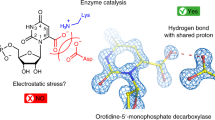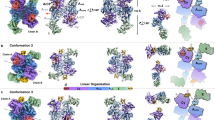Abstract
Carboxylic acid reductase (CAR) catalyzes the ATP- and NADPH-dependent reduction of carboxylic acids to the corresponding aldehydes. The enzyme is related to the nonribosomal peptide synthetases, consisting of an adenylation domain fused via a peptidyl carrier protein (PCP) to a reductase termination domain. Crystal structures of the CAR adenylation–PCP didomain demonstrate that large-scale domain motions occur between the adenylation and thiolation states. Crystal structures of the PCP–reductase didomain reveal that phosphopantetheine binding alters the orientation of a key Asp, resulting in a productive orientation of the bound nicotinamide. This ensures that further reduction of the aldehyde product does not occur. Combining crystallography with small-angle X-ray scattering (SAXS), we propose that molecular interactions between initiation and termination domains are limited to competing PCP docking sites. This theory is supported by the fact that (R)-pantetheine can support CAR activity for mixtures of the isolated domains. Our model suggests directions for further development of CAR as a biocatalyst.
This is a preview of subscription content, access via your institution
Access options
Access Nature and 54 other Nature Portfolio journals
Get Nature+, our best-value online-access subscription
$29.99 / 30 days
cancel any time
Subscribe to this journal
Receive 12 print issues and online access
$259.00 per year
only $21.58 per issue
Buy this article
- Purchase on Springer Link
- Instant access to full article PDF
Prices may be subject to local taxes which are calculated during checkout





Similar content being viewed by others
References
Gross, G.G. Formation and reduction of intermediate acyladenylate by aryl-aldehyde. NADP oxidoreductase from Neurospora crassa. Eur. J. Biochem. 31, 585–592 (1972).
He, A., Li, T., Daniels, L., Fotheringham, I. & Rosazza, J.P.N. Nocardia sp. carboxylic acid reductase: cloning, expression, and characterization of a new aldehyde oxidoreductase family. Appl. Environ. Microbiol. 70, 1874–1881 (2004).
Akhtar, M.K., Turner, N.J. & Jones, P.R. Carboxylic acid reductase is a versatile enzyme for the conversion of fatty acids into fuels and chemical commodities. Proc. Natl. Acad. Sci. USA 110, 87–92 (2013).
Strieker, M., Tanović, A. & Marahiel, M.A. Nonribosomal peptide synthetases: structures and dynamics. Curr. Opin. Struct. Biol. 20, 234–240 (2010).
Gulick, A.M. Structural insight into the necessary conformational changes of modular nonribosomal peptide synthetases. Curr. Opin. Chem. Biol. 35, 89–96 (2016).
Drake, E.J. et al. Structures of two distinct conformations of holo-non-ribosomal peptide synthetases. Nature 529, 235–238 (2016).
Reimer, J.M., Aloise, M.N., Harrison, P.M. & Schmeing, T.M. Synthetic cycle of the initiation module of a formylating nonribosomal peptide synthetase. Nature 529, 239–242 (2016).
Lennen, R.M. & Pfleger, B.F. Microbial production of fatty acid-derived fuels and chemicals. Curr. Opin. Biotechnol. 24, 1044–1053 (2013).
Kallio, P., Pásztor, A., Thiel, K., Akhtar, M.K. & Jones, P.R. An engineered pathway for the biosynthesis of renewable propane. Nat. Commun. 5, 4731 (2014).
Duan, Y. et al. Synthesis of α,β-unsaturated esters via a chemo-enzymatic chain elongation approach by combining carboxylic acid reduction and Wittig reaction. Beilstein J. Org. Chem. 11, 2245–2251 (2015).
Xu, P., Qiao, K., Ahn, W.S. & Stephanopoulos, G. Engineering Yarrowia lipolytica as a platform for synthesis of drop-in transportation fuels and oleochemicals. Proc. Natl. Acad. Sci. USA 113, 10848–10853 (2016).
Zhou, Y.J. et al. Production of fatty acid-derived oleochemicals and biofuels by synthetic yeast cell factories. Nat. Commun. 7, 11709 (2016).
France, S.P. et al. One pot cascade synthesis of mono- and di-substituted piperidines and pyrrolidines using carboxylic acid reductase (CAR), ω-transaminase (ω-TA) and imine reductase (IRED) biocatalysts. ACS Catal. 6, 3753–3759 (2016).
Finnigan, W. et al. Characterization of carboxylic acid reductases as enzymes in the toolbox for synthetic chemistry. ChemCatChem 9, 1005–1017 (2017).
Gulick, A.M. Conformational dynamics in the Acyl-CoA synthetases, adenylation domains of non-ribosomal peptide synthetases, and firefly luciferase. ACS Chem. Biol. 4, 811–827 (2009).
Chhabra, A. et al. Nonprocessive [2 + 2]e- off-loading reductase domains from mycobacterial nonribosomal peptide synthetases. Proc. Natl. Acad. Sci. USA 109, 5681–5686 (2012).
Barajas, J.F. et al. Comprehensive structural and biochemical analysis of the terminal myxalamid reductase domain for the engineered production of primary alcohols. Chem. Biol. 22, 1018–1029 (2015).
Marahiel, M.A., Stachelhaus, T. & Mootz, H.D. Modular peptide synthetases involved in nonribosomal peptide synthesis. Chem. Rev. 97, 2651–2674 (1997).
Thornburg, C.K., Wortas-Strom, S., Nosrati, M., Geiger, J.H. & Walker, K.D. Kinetically and crystallographically guided mutations of a benzoate coa ligase (Bada) elucidate mechanism and expand substrate permissivity. Biochemistry 54, 6230–6242 (2015).
Kochan, G., Pilka, E.S., von Delft, F., Oppermann, U. & Yue, W.W. Structural snapshots for the conformation-dependent catalysis by human medium-chain acyl-coenzyme A synthetase ACSM2A. J. Mol. Biol. 388, 997–1008 (2009).
Kavanagh, K.L., Jörnvall, H., Persson, B. & Oppermann, U. Medium- and short-chain dehydrogenase/reductase gene and protein families : the SDR superfamily: functional and structural diversity within a family of metabolic and regulatory enzymes. Cell. Mol. Life Sci. 65, 3895–3906 (2008).
Awodi, U.R., Ronan, J.L., Masschelein, J., de Los Santos, E.L.C. & Challis, G.L. Thioester reduction and aldehyde transamination are universal steps in actinobacterial polyketide alkaloid biosynthesis. Chem. Sci. 8, 411–415 (2017).
Peng, H. et al. Deciphering piperidine formation in polyketide-derived indolizidines reveals a thioester reduction, transamination, and unusual imine reduction process. ACS Chem. Biol. 11, 3278–3283 (2016).
Mootz, H.D., Schwarzer, D. & Marahiel, M.A. Construction of hybrid peptide synthetases by module and domain fusions. Proc. Natl. Acad. Sci. USA 97, 5848–5853 (2000).
Hur, G.H., Vickery, C.R. & Burkart, M.D. Explorations of catalytic domains in non-ribosomal peptide synthetase enzymology. Nat. Prod. Rep. 29, 1074–1098 (2012).
Calcott, M.J. & Ackerley, D.F. Portability of the thiolation domain in recombinant pyoverdine non-ribosomal peptide synthetases. BMC Microbiol. 15, 162 (2015).
Khosla, C., Herschlag, D., Cane, D.E. & Walsh, C.T. Assembly line polyketide synthases: mechanistic insights and unsolved problems. Biochemistry 53, 2875–2883 (2014).
Merdanovic, M., Mönig, T., Ehrmann, M. & Kaiser, M. Diversity of allosteric regulation in proteases. ACS Chem. Biol. 8, 19–26 (2013).
Kornev, A.P. & Taylor, S.S. Dynamics-driven allostery in protein kinases. Trends Biochem. Sci. 40, 628–647 (2015).
Langelier, M.F. & Pascal, J.M. PARP-1 mechanism for coupling DNA damage detection to poly(ADP-ribose) synthesis. Curr. Opin. Struct. Biol. 23, 134–143 (2013).
Dowling, D.P. et al. Structural elements of an NRPS cyclization domain and its intermodule docking domain. Proc. Natl. Acad. Sci. USA 113, 12432–12437 (2016).
O'Connor, S.E., Walsh, C.T. & Liu, F. Biosynthesis of epothilone intermediates with alternate starter units: engineering polyketide-nonribosomal interfaces. Angew. Chem. Int. Edn Engl. 42, 3917–3921 (2003).
Yin, J., Lin, A.J., Golan, D.E. & Walsh, C.T. Site-specific protein labeling by Sfp phosphopantetheinyl transferase. Nat. Protoc. 1, 280–285 (2006).
Winter, G., Lobley, C.M. & Prince, S.M. Decision making in xia2. Acta Crystallogr. D Biol. Crystallogr. 69, 1260–1273 (2013).
Sheldrick, G.M. Experimental phasing with SHELXC/D/E: combining chain tracing with density modification. Acta Crystallogr. D Biol. Crystallogr. 66, 479–485 (2010).
Emsley, P., Lohkamp, B., Scott, W.G. & Cowtan, K. Features and development of Coot. Acta Crystallogr. D Biol. Crystallogr. 66, 486–501 (2010).
Adams, P.D. et al. PHENIX: a comprehensive Python-based system for macromolecular structure solution. Acta Crystallogr. D Biol. Crystallogr. 66, 213–221 (2010).
McCoy, A.J. et al. Phaser crystallographic software. J. Appl. Crystallogr. 40, 658–674 (2007).
Kabsch, W. XDS. Acta Crystallogr. D Biol. Crystallogr. 66, 125–132 (2010).
Murshudov, G.N., Vagin, A.A. & Dodson, E.J. Refinement of macromolecular structures by the maximum-likelihood method. Acta Crystallogr. D Biol. Crystallogr. 53, 240–255 (1997).
Chen, V.B. et al. MolProbity: all-atom structure validation for macromolecular crystallography. Acta Crystallogr. D Biol. Crystallogr. 66, 12–21 (2010).
Joosten, R.P., Long, F., Murshudov, G.N. & Perrakis, A. The PDB_REDO server for macromolecular structure model optimization. IUCrJ 1, 213–220 (2014).
Petoukhov, M.V. et al. New developments in the ATSAS program package for small-angle scattering data analysis. J. Appl. Crystallogr. 45, 342–350 (2012).
Rambo, R.P. & Tainer, J.A. Accurate assessment of mass, models and resolution by small-angle scattering. Nature 496, 477–481 (2013).
Svergun, D., Barberato, C. & Koch, M.H.J. CRYSOL—a program to evaluate X-ray solution scattering of biological macromolecules from atomic coordinates. J. Appl. Crystallogr. 28, 768–773 (1995).
Schneidman-Duhovny, D., Hammel, M. & Sali, A. FoXS: a web server for rapid computation and fitting of SAXS profiles. Nucleic Acids Res. 38, W540–W544 (2010).
Schneidman-Duhovny, D., Hammel, M., Tainer, J.A. & Sali, A. FoXS, FoXSDock and MultiFoXS: single-state and multi-state structural modeling of proteins and their complexes based on SAXS profiles. Nucleic Acids Res. 44, W1, W424–W429 (2016).
Tria, G., Mertens, H.D.T., Kachala, M. & Svergun, D.I. Advanced ensemble modelling of flexible macromolecules using X-ray solution scattering. IUCrJ 2, 207–217 (2015).
Schuck, P. Size-distribution analysis of macromolecules by sedimentation velocity ultracentrifugation and lamm equation modeling. Biophys. J. 78, 1606–1619 (2000).
Hayes, D., Laue, T. & Philo, J. Program Sednterp: Sedimentation Interpretation Program. (Alliance Protein Laboratories, Thousand Oaks, California, USA) (1995).
Pudney, C.R., Hay, S. & Scrutton, N.S. Practical aspects on the use of kinetic isotope effects as probes of flavoprotein enzyme mechanisms. Methods Mol. Biol. 1146, 161–175 (2014).
Hay, S., Pudney, C.R., Sutcliffe, M.J. & Scrutton, N.S. Are environmentally coupled enzymatic hydrogen tunneling reactions influenced by changes in solution viscosity? Angew. Chem. Int. Ed. Engl. 47, 537–540 (2008).
Acknowledgements
This work was supported by BBSRC grant (BB/K00199X/1 to N.T., N.S.S. and D.L.). We thank the BBSRC/EPSRC SYNBIOCHEM Centre (grant BB/M017702/1 to N.T., N.S.S. and D.L.) for access to analytical equipment. We thank the Diamond Light Source for access to beam lines for macromolecular crystallography and bio-SAXS (proposal number MX12788). D.L. and N.T. are Royal Society Wolfson Merit Award holders. N.S.S. is an EPSRC Established Career Fellow. We thank the CoEBio3 Affiliates programme for funding to A.H.
Author information
Authors and Affiliations
Contributions
M.S.D. cloned, expressed and purified various CAR enzymes (both truncations and full-length as well as hybrid forms) and obtained crystal structures for both A and R domains. D.G. cloned, expressed and purified various CAR enzymes and obtained crystals structures for the PCP-didomain constructs in addition to isolated R domain structures. D.G. and M.P.L.-C. performed SAXS data collection and modeling. E.K., D.Q., A.M.H. and S.R.D. performed kinetic data analysis. All authors discussed the results and participated in writing of the manuscript. N.J.T., N.S.S. and D.L. initiated and directed this research.
Corresponding author
Ethics declarations
Competing interests
The authors declare no competing financial interests.
Supplementary information
Supplementary Text and Figures
Supplementary Results, Supplementary Figures 1–10 and Supplementary Table 1 (PDF 16995 kb)
Rights and permissions
About this article
Cite this article
Gahloth, D., Dunstan, M., Quaglia, D. et al. Structures of carboxylic acid reductase reveal domain dynamics underlying catalysis. Nat Chem Biol 13, 975–981 (2017). https://doi.org/10.1038/nchembio.2434
Received:
Accepted:
Published:
Issue Date:
DOI: https://doi.org/10.1038/nchembio.2434
This article is cited by
-
Thioester-mediated biocatalytic amide bond synthesis with in situ thiol recycling
Nature Catalysis (2022)
-
Protocatechuic acid attenuates isoproterenol-induced cardiac hypertrophy via downregulation of ROCK1–Sp1–PKCγ axis
Scientific Reports (2021)
-
Biosynthesis of C12 Fatty Alcohols by Whole Cell Biotransformation of C12 Derivatives Using Escherichia coli Two-cell Systems Expressing CAR and ADH
Biotechnology and Bioprocess Engineering (2021)
-
Enzymatic C–H activation of aromatic compounds through CO2 fixation
Nature Chemical Biology (2020)
-
Highly thermostable carboxylic acid reductases generated by ancestral sequence reconstruction
Communications Biology (2019)



